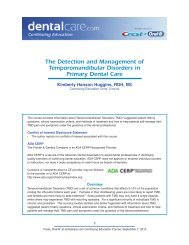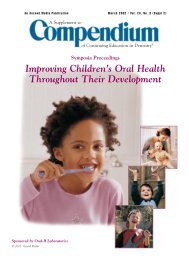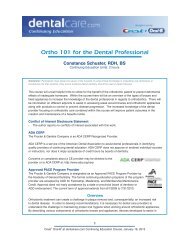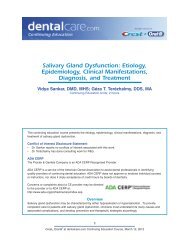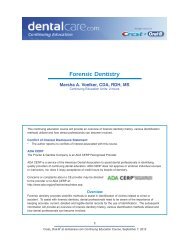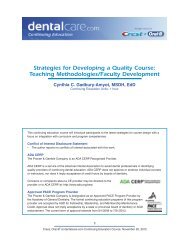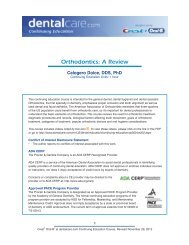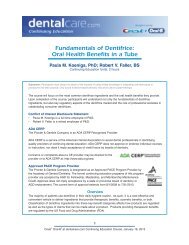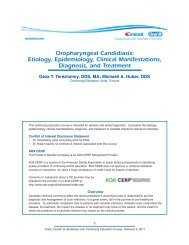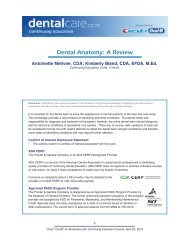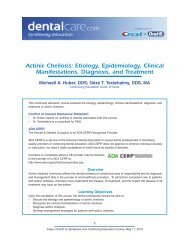CE 391 - Management of Pediatric Medical ... - DentalCare.com
CE 391 - Management of Pediatric Medical ... - DentalCare.com
CE 391 - Management of Pediatric Medical ... - DentalCare.com
Create successful ePaper yourself
Turn your PDF publications into a flip-book with our unique Google optimized e-Paper software.
can be devastating. Death may result or if<br />
the patient is resuscitated, permanent brain<br />
damage is possible. The etiology <strong>of</strong> cardiac<br />
arrest in a child differs from an adult. Cardiac<br />
arrest in the pediatric patient is the result <strong>of</strong><br />
prolonged respiratory depression and apnea.<br />
These situations are <strong>of</strong>ten associated with local<br />
anesthesia toxicity as a result <strong>of</strong> overdose or<br />
intravascular injection and with the administration<br />
<strong>of</strong> CNS depressant drugs for behavior<br />
management.<br />
Comprehensive BLS training is not within the<br />
scope <strong>of</strong> the course and it is re<strong>com</strong>mended the<br />
reader seek out formal BLS instruction. Because<br />
the etiologies for cardiac arrest differ for adults<br />
(cardiac disease) and children (depleted oxygen<br />
in the mycocardium) differ, the 2010 American<br />
Heart Association guidelines for basic life support<br />
for differ.<br />
For unwitnessed and witnessed cardiac arrests<br />
with two or more rescuers present, assess the<br />
patient, initiate CPR, activate the emergency<br />
response system and obtain an automated<br />
external defibrillator (AED) simultaneously.<br />
For the lone rescuer, the sequence varies:<br />
• If the cardiac arrest is witnessed, the lone<br />
rescuer first activates the emergency response<br />
system, obtains an AED, and starts CPR.<br />
This approach is the same as for adult with<br />
cardiac arrest.<br />
• If the cardiac arrest is unwitnessed, the lone<br />
rescuer should first perform two minutes<br />
<strong>of</strong> CPR, activate the emergency response<br />
system, and obtain an AED. This approach<br />
differs from that re<strong>com</strong>mended for adult<br />
17<br />
cardiac arrest which is call for help, activate the<br />
emergency response system and initate CPR<br />
and obtain an AED.<br />
Comprehensive CPR training is not within the<br />
scope <strong>of</strong> this course and it is re<strong>com</strong>mended the<br />
reader seek out formal BLS instruction. It is<br />
important for BLS providers to realize because<br />
<strong>of</strong> different etiologies for cardiac arrest in adults<br />
(cardiac disease) and children (depleted oxygen in<br />
the myocardium) there is a significant difference in<br />
BLS protocols for adults and children.<br />
In adults, after initial assessment <strong>of</strong> the<br />
unresponsive patient, EMS is activated<br />
immediately (before starting BLS) so access to<br />
trained personnel and defibrillation equipment is<br />
available as soon as possible. In children, since<br />
the likely cause <strong>of</strong> cardiac arrest is lack <strong>of</strong> oxygen<br />
in cardiac muscle, BLS is started immediately<br />
and EMS is contacted after delivery <strong>of</strong> BLS for 2<br />
minutes. If two rescuers are present, one starts<br />
BLS while the other activates EMS and obtains the<br />
defibrillation equipment.<br />
Conclusion<br />
In summary, although pediatric medical<br />
emergencies are a rare occurrence in the dental<br />
<strong>of</strong>fice, when it does occur, it is important the<br />
staff is well trained in emergency management<br />
so efficient and timely treatment is administered<br />
to the physically and physiologically immature<br />
pediatric patient. Preparation includes the use<br />
<strong>of</strong> <strong>com</strong>prehensive medical and dental histories,<br />
at minimum BLS training for staff and providers,<br />
initiation <strong>of</strong> an <strong>of</strong>fice emergency team, organization<br />
<strong>of</strong> an emergency drug kit and equipment, and<br />
periodic reviews and simulation.<br />
Crest ® Oral-B ®<br />
at dentalcare.<strong>com</strong> Continuing Education Course, May 11, 2012




